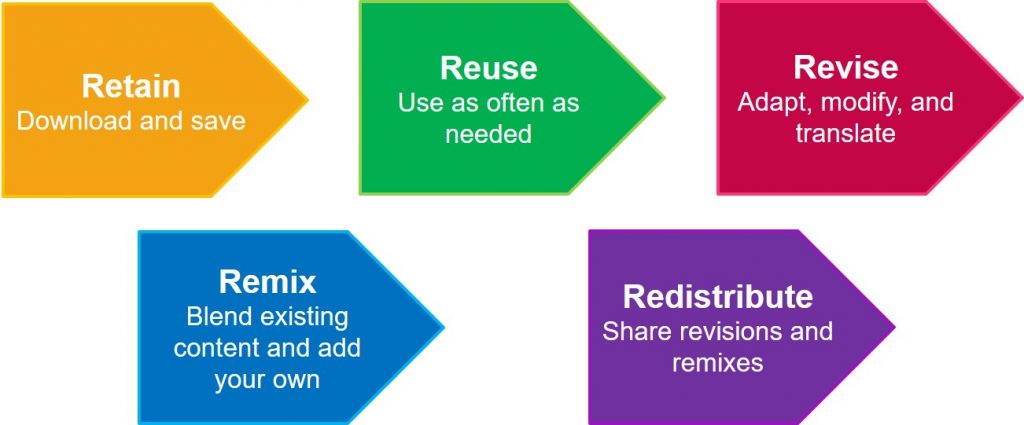Introduction – The What and Why of OER
What are Open Educational Resources?[1]
OER = Free + 5 Rs
OER are learning and teaching materials that are freely and openly available. They range from textbooks to entire courses and everything in between, including videos, podcasts, tests and exercises, websites, software, simulations, case studies, presentations slides, and more. The key is that they can be widely distributed and adapted because they are at no cost to the user and are not subject to the usual copyright restrictions. This openness is most often indicated by a Creative Commons licence.
What can be done with OER? The 5 Rs

Benefits of OER
- OER are affordable for students, making education more accessible.
- OER allow you to customize and adapt to the course context, providing a richer teaching and learning opportunity.
- Students can benefit from multiple learning approaches because OER can incorporate various content formats (text, audio, video or multimedia) and interactive elements.
- Remote and continued access since most OER are digital, do not require an access code and do not expire.
- Contribute to students’ success and completion by easing their financial burden without having a negative impact on their learning.[2]
The adaptation of existing OER and the creation of new resources are also opportunities to make course materials more accessible, inclusive, and representative for learners. This kind of flexibility rarely exists in traditional textbooks. Because OER are not created to satisfy a commercial market, they can address topics and include perspectives that would otherwise be neglected.
What are Creative Commons (CC) licences?
Creative Commons licences act like a permission. When a creator applies one of the six free licences on their work, they retain their copyright but allow the public to share, remix and reuse the work legally without having to ask permission or pay additional fees, provided that the user complies with the conditions of the licence.
CC licences consist of two elements: the CC logo and icons representing a combination of conditions (which can also be represented by two letters or written out in long form).

The most open of these licences is CC BY, requiring attribution only. The most restrictive (but still more open than copyright’s “all rights reserved” approach) is CC BY-NC-ND, which requires attribution but does not allow for commercial use and adaptations.
Note: Resources with the ND condition are technically not OER. ND indicates that the user cannot make changes to the original version to incorporate it into a new resource. This condition goes against two of the five Rs: revising and remixing.
Learn more about CC licences on the Creative Commons website.
- This section is reproduced from the University of Ottawa Library OER guide, "Open Educational Resources (OER)", CC BY 4.0 ↵
- V. Clinton & S. Khan, (2019), “Efficacy of Open Textbook Adoption on Learning Performance and Course Withdrawal Rates: A Meta-Analysis,” AERA Open, CC BY-NC 4.0. R.S. Jhangiani et al., (2018), “As Good or Better than Commercial Textbooks: Students’ Perceptions and Outcomes from Using Open Digital and Open Print Textbooks,” The Canadian Journal for the Scholarship of Teaching and Learning 9(1). C. Hendricks et al., (2017), “The Adoption of an Open Textbook in a Large Physics Course: An Analysis of Cost, Outcomes, Use, and Perceptions,” The International Review of Research in Open and Distributed Learning 18(4), CC BY 4.0. H.M. Ross et al., (2018), “Open Textbooks in an Introductory Sociology Course in Canada: Student Views and Completion Rates,” Open Praxis 10(4), CC BY 4.0. ↵

